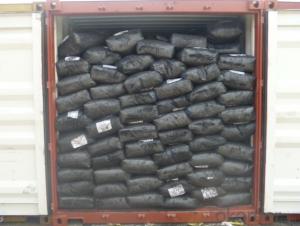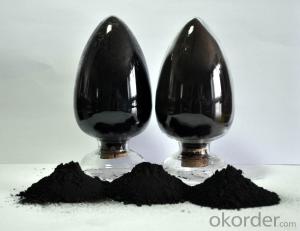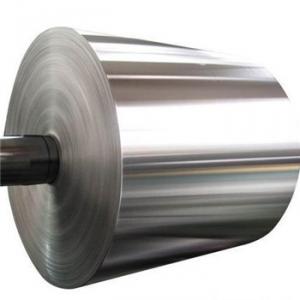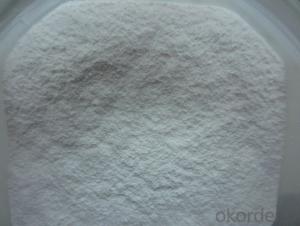Aluminum Sulfate Used For Paper
- Loading Port:
- Qingdao
- Payment Terms:
- TT OR LC
- Min Order Qty:
- -
- Supply Capability:
- 12000 m.t./month
OKorder Service Pledge
OKorder Financial Service
You Might Also Like
1. Chemical and Physical Properties:
Product name: Aluminium Sulphate or Aluminum Sulfate
Shape: Flakes or Granular or Powder.
EINECS NO.:233-135-0
CAS No.: 10043-01-3
HS.Code: 28332200
Molecular Formula: Al2(SO4)3
Appearance:It is white or grey flake,particle or massive crystallization.
Apt to cake after moisture absorption when laid in air for a long time.A little green because of Fe2+ ,yellow when Fe2+ is oxided to Fe3+.Soluble in water easily,and water solution is acid.
2. Specification:
Standard: HG/T 2225-2001 and HG/T 2227-2004
Items | Specifications | |||
I Type:Low Ferrous/Low Iron | II Type:Non-Ferrous/Iron-free | |||
First Class | Qualified | First Class | Qualified | |
Al2O3 % ≥ | 15.8 | 15.6 | 17 | 16 |
Ferrous(Fe )% ≤ | 0.5 | 0.7 | 0.005 | 0.01 |
Water Insolube % ≤ | 0.1 | 0.15 | 0.1 | 0.15 |
PH (1% aqueous solution) ≥ | 3.0 | 3.0 | 3.0 | 3.0 |
Arsenic(As) %≤ | 0.0005 | 0.0005 | ||
Heavy metal (Pb) %≤ | 0.002 | 0.002 | ||
3.Applications:
Water effluent treatment system
It's used for purification of drinking water and wastewater treatment by settling of impurities by
means of precipitation and flocculation.
Paper Industry
It helps in sizing of paper at neutral and alkaline pH, thus improving paper quality (reducing spots
and holes and improving sheet formation and strength) and sizing efficiency.
Textile Industry
It is used for color fixing in Naphthol based dyes for cotton fabric.
Other Uses
Leather tanning, lubricating compositions, fire retardants; decolorizing agent in petroleum, deodorizer; food additive; firming agent; dyeing mordant; foaming agent in firefighting foams; fireproofing cloth; catalyst; pH control; waterproofing concrete; aluminum compounds, zeolites etc.
4. Package:
Packaging Detail: PP/PE 50kg/bag;25kg/bag;Jumbo bag or according to customers' requirements.
20-25MT will be loaded in per 20'FCL container.
5. Attention and Storage:
The product is liable to absorb moisture and clot due to long-term exposure, so shady, cool and ventilated environment is needed.
- Q: Always speeds the reation ratedoes not affect the reation rateundergoes a chemical changedoes not become part of the chemical changealways slows the reation rate
- Does not become part of the chemical change. I am guessing that this is a multiple guess test and the answer you are looking for is D.
- Q: what is the role of a catalyst in a chemical reaction?
- A catalyst speeds up a chemical reaction by providing an alternate reaction pathway with a lower activation energy. Since the activation energy is lower, more product will be formed in the same amount of time. Chemists used to assume that a catalyst somehow sped up a reaction without being consumed in the reaction. We now know that a catalyst will be a reactant in one step of a reaction mechanism, and will be a product in a subsequent step in the mechanism, so that it **appears** that the catalyst does not take part in the reaction. ======== Follow up ========= Remember, it is customary to cite one's sources when quoting from another source or when simply copying large passages from Wikipedia or some other web page.
- Q: What is the microcosmic principle of the catalytic reaction in the chemical reaction?
- It is actually directly involved in the reaction, but, after the reaction, it has become a product out, the equivalent of no response
- Q: What is chemical adsorption and its relationship with heterogeneous catalysis
- The catalytic cycle includes five steps: diffusion, chemical adsorption, surface reaction, desorption and reverse diffusion.The chemical adsorption is an important part of the heterogeneous catalysis process, and the adsorption of the reactants on the catalyst surface,
- Q: What is the catalytic efficiency of ordinary chemical catalysts?
- Different reactions, with the same catalyst, the catalytic efficiency is different. The same reaction, with different catalysts, the catalytic efficiency is also different
- Q: how can you tell when a substance serves as a catalyst?
- It makes a reaction run faster and better AND it is not used up by the reaction
- Q: I have just spent CAN$550 to replace a catalyst converter at one end of the muffler. The repairman said I need to replace the oxygen sensor very soon, otherwise, the C.C. will be gone again. Is that true... can someone confirm this for me. Thanks.
- your O2 sensor measures the amount of oxygen remaining in the exhaust gas after the combustion process. The left over oxygen reacts with the sensor to send an electrical signal to your vehicles computer. the computer can then adjust your fuel injector pulse width in order to maintain the proper 14.7:1 air/fuel ratio. Excessive exhaust gases are the usual culprit when catalatyc converters fail. Even so the O2 sensor is usually fairly cheap ($20-$30) and simple to replace. I would replace it as cheap insurance
- Q: Is the enzyme in the enzyme bigger than gold?
- A biological enzyme is equivalent to a key that opens a complex compound whose importance is that its unique structure or multidimensional shape matches a part of the group. Once these two parts are combined, the specific chemical bond in the group molecule changes as if the lock was opened. When the reaction is completed, the enzyme is released and repeated with the next group, followed by repeated repeats. Many chemical reactions in the normal temperature conditions, the reaction is very slow so that the whole process is difficult to be perceived.
- Q: Will the catalyst decompose during the reaction between two substances? Exp:the decomposition of hydrogen peroxide.Will the manganese 4 oxide decompose?
- Catalysts are not used/destroyed in any reactions, it merely speeds up the process by lowering the reaction activation energy. It functions by being able to weaken or break the required bonds necessary in the chemical reaction (thus lowering activation energy) through temporary and weak bonding to form a complex. In this case the H2O2 molecule will bind with the MnO2 molecule due to the complimentary sites (thus forming a complex) to weaken the bonds for decomposition, but after decomposition the products (oxygen and water molecules) break off from the catalyst (as there are no more complementary sites with them) thus the catalyst will not be destroyed.
Send your message to us
Aluminum Sulfate Used For Paper
- Loading Port:
- Qingdao
- Payment Terms:
- TT OR LC
- Min Order Qty:
- -
- Supply Capability:
- 12000 m.t./month
OKorder Service Pledge
OKorder Financial Service
Similar products
Hot products
Hot Searches
Related keywords






















